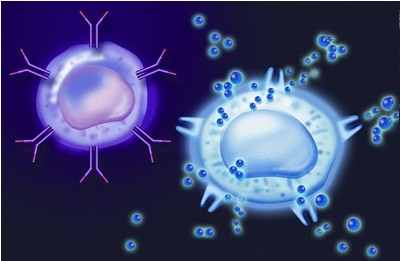
人体皮肤包含大约200亿个记忆T细胞,是免疫细胞库的一部分,保护宿主不受众多病原体的侵害。三月十八日在《科学转化医学》(Science Translational Medicine)发表的一项研究,对这些皮肤记忆性T细胞进行了分析和归类。
洛克菲勒大学皮肤病专家James Krueger没有参与这项工作,他评论说:“这项工作对皮肤免疫系统,进行了关键性和开创性的重新定义。”
明尼苏达大学的免疫学家David Masopust指出:“记忆T细胞是适应性免疫系统的一部分。在历史上,我们通过在免疫系统自身的器官(如淋巴结)中研究这些细胞,已经了解了自适应(T细胞 )反应。那是因为人们长期以来推测,虽然T细胞访问过人体的外周组织,它们最终会回流到淋巴结。但是,最近的证据显示,某些T细胞永远存在于外周组织。它们在你生病、受感染的时候进来,但是他们本质上适应那个组织环境,使它们生活在那里。”
事实上,布里格姆妇女医院的Rachael Clark和她的同事们以前曾发现了一组记忆T细胞,它们从未离开过皮肤——所谓的定居细胞(resident cell)。现在她和她的同事们更深入地研究了这些细胞,发现了两种不同的类型。此外,Clark的研究小组发现,皮肤还有两种类型的记忆T细胞来来往往——所谓的再循环细胞。这四种记忆细胞类型,每种都有其自身的特点。
幼稚细胞暴露于病原体后会产生记忆T细胞。因为新生婴儿几乎没有机会接触到病原体,他们的皮肤就像一块干净的石板,几乎没有记忆性T细胞。因此,为了研究新记忆T细胞的浸润和发展,Clark的研究团队将新生儿包皮——从包皮环切术中收集,移植到缺乏功能性免疫系统的小鼠中。然后研究人员给动物静脉注射捐献的成人血。供体免疫细胞浸润皮肤移植物,因为它是外来的,会产生一种适应性免疫应答——表现为皮炎,在此期间记忆T细胞形成。
为了研究定居记忆细胞,研究小组随后用药物(称为阿仑单抗)处理小鼠,药物会特异性地消耗再循环细胞,而不是定居的记忆T细胞。研究人员发现,根据一种细胞表面标记(称为CD103)的表达,剩余的定居细胞可分成两类。表达CD103的记忆细胞优先居住在外层皮肤(表皮),产生大量的细胞因子,并最低限度地增殖。另一方面,缺乏CD103的细胞优先驻留在皮肤基底层(真皮),有减少的但仍然强大的细胞因子产生,并增殖更多。
该研究团队还发现,这些相同的定居记忆T细胞,也存在于健康人和阿仑单抗治疗的淋巴瘤患者的皮肤。除了定居细胞之外,Clark研究团队发现,人的皮肤含有两种循环记忆T细胞——它们在另一个表面标志物的表达以及再循环的速度方面存在差异。与定居细胞相比,两种再循环记忆细胞的细胞因子生产降低。Clark说:“总之,这些结果表明,免疫系统通过提供两种非常强大的战士(可局部防止感染都)来保护皮肤,这些可高度移动的信使,可以从一个地方移到另一个地方,在皮肤和其他组织的不同部位响应感染。”
Clark说,知道了是什么控制这些特异性记忆T细胞的发展,并进一步表征其功能,可以为特定免疫性疾病的个性化治疗提供了潜力。她说:“例如,银屑病、蕈样肉芽肿(一种皮肤T细胞淋巴瘤)和固定型药疹(由药物引起的皮疹),都被证明是由定居记忆细胞引起的。一旦我们更好地了解了这些细胞的生物学,我们就可以选择性地消除它们。”
原文链接:Human skin is protected by four functionally and phenotypically discrete populations of resident and recirculating memory T cells
The skin of an adult human contains about 20 billion memory T cells. Epithelial barrier tissues are infiltrated by a combination of resident and recirculating T cells in mice, but the relative proportions and functional activities of resident versus recirculating T cells have not been evaluated in human skin. We discriminated resident from recirculating T cells in human-engrafted mice and lymphoma patients using alemtuzumab, a medication that depletes recirculating T cells from skin, and then analyzed these T cell populations in healthy human skin. All nonrecirculating resident memory T cells (TRM) expressed CD69, but most were CD4+, CD103-, and located in the dermis, in contrast to studies in mice. Both CD4+ and CD8+ CD103+ TRM were enriched in the epidermis, had potent effector functions, and had a limited proliferative capacity compared to CD103- TRM. TRM of both types had more potent effector functions than recirculating T cells. We observed two distinct populations of recirculating T cells, CCR7+/L-selecin+ central memory T cells (TCM) and CCR7+/L-selectin- T cells, which we term migratory memory T cells (TMM). Circulating skin-tropic TMM were intermediate in cytokine production between TCM and effector memory T cells. In patients with cutaneous T cell lymphoma, malignant TCM and TMMinduced distinct inflammatory skin lesions, and TMM were depleted more slowly from skin after alemtuzumab, suggesting that TMM may recirculate more slowly. In summary, human skin is protected by four functionally distinct populations of T cells, two resident and two recirculating, with differing territories of migration and distinct functional activities.

